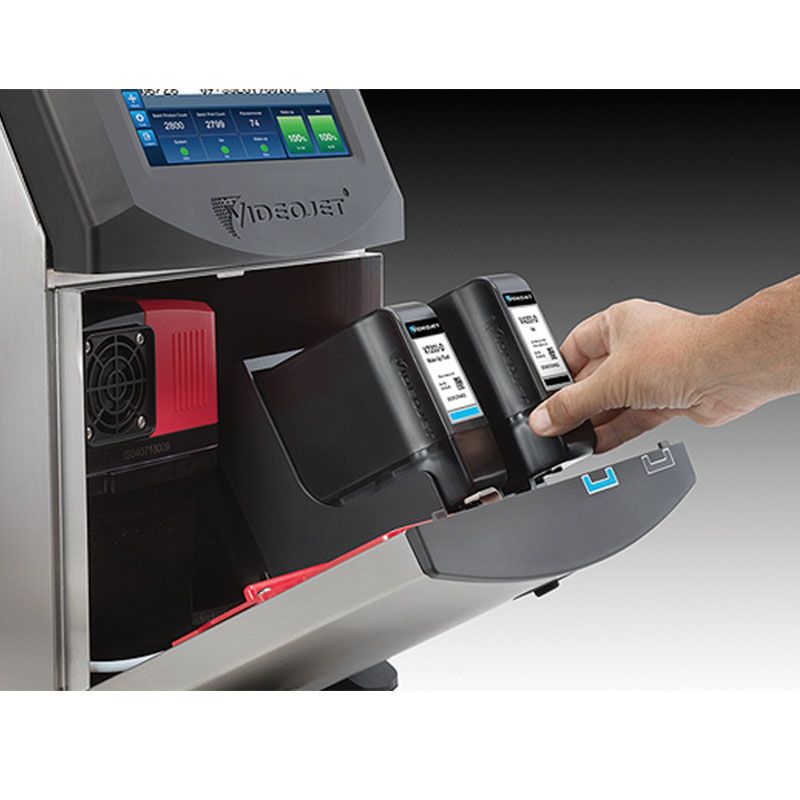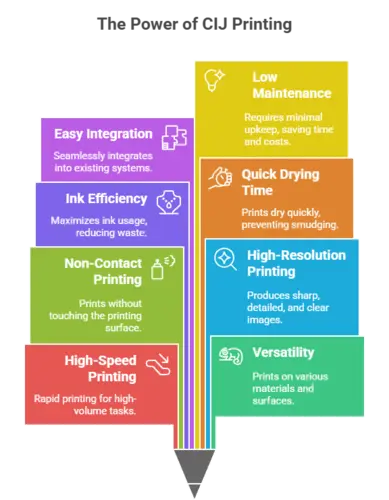Continuous Inkjet (CIJ) printer have emerged as an integral part of the printing industry, revolutionizing the way we produce high-quality prints on various surfaces. From product packaging to industrial coding, CIJ technology offers efficient and cost-effective solutions to meet diverse printing needs.
Through a remarkable technique, CIJ printers propel a continuous stream of ink onto the printing substrate, ensuring precision and accuracy. In this blog, we delve into the inner workings of CIJ printers, exploring the intricate mechanisms that drive their functionality. Join us as we unravel the mysteries behind this remarkable printing technology and its myriad applications.

What Is A Continuous Inkjet (Cij) Printer?
A continuous inkjet printer is a type of printing technology that is widely used in various industries for high-speed and high-volume printing applications. It works by propelling tiny droplets of ink onto a substrate, such as paper or plastic, to create text, images, or codes. Here are five key features of continuous inkjet printers:
- Non-contact printing: Continuous inkjet printers use a non-contact method, where the ink droplets are propelled onto the substrate without physically touching it. This allows printing on delicate or uneven surfaces and eliminates the risk of damage to the substrate.
- High-speed printing: Continuous inkjet printers are designed for rapid printing speeds, making them suitable for applications that require large quantities of printed materials within a short period. They can produce thousands of prints per minute, ensuring efficient and productive operations.
- Versatile ink compatibility: These printers are compatible with a wide range of inks, including both dye-based and pigment-based inks. This versatility allows for printing on different materials and facilitates the creation of vibrant, durable prints with excellent color reproduction.
- Variable data printing: Continuous inkjet printers excel at variable data printing. This involves the customization of each print with unique information. This feature is particularly useful in applications like product packaging, where individual barcodes, expiration dates, or serial numbers need to be printed.
- Maintenance and reliability: Continuous inkjet printers are designed with features that minimize downtime and simplify maintenance tasks. They typically have self-cleaning mechanisms to prevent nozzle clogging and ensure consistent print quality. Additionally, many models offer user-friendly interfaces and diagnostic tools to facilitate troubleshooting and reduce the need for technical expertise.
Overall, continuous inkjet printers are known for their speed, versatility, and ability to handle demanding printing requirements. This makes them a popular choice in industries such as packaging, manufacturing, and coding.
Continuous Inkjet (Cij) Printer Working?
A continuous inkjet printer is a type of printer that uses a continuous stream of ink droplets to create printed images or text. Here is a step-by-step explanation of how a continuous inkjet printer works:
1. Ink Supply:
The printer is equipped with an ink reservoir or a continuous ink supply system (CISS) that provides a constant flow of ink to the printing system.
2. Ink Circulation:
The ink is circulated through a series of tubes and filters to ensure consistent ink quality and prevent clogging.
3. Printhead Assembly:
The printer has a specialized component called the printhead assembly, which consists of several key elements.
4. Pumping System:
A pump within the printer creates pressure to force the ink through a small nozzle or orifice in the printhead.
5. Charging Electrodes:
The printhead contains charging electrodes that apply an electrical charge to the ink as it passes through the nozzle. The ink droplets become electrically charged as they break away from the continuous ink stream.
6. Deflection Plates:
After passing through the charging electrodes, the ink droplets enter a region with two deflection plates. These plates are charged with opposite polarities, creating an electric field.
7. Ink Droplet Deflection:
The charged ink droplets are deflected by the electric field, causing them to follow different paths depending on their charge polarity. This deflection allows for precise control over the ink droplets’ trajectories.
8. Print Control System:
A control system in the printer synchronizes the charging of the ink droplets and the deflection plates to create the desired image or text. By selectively activating the charging electrodes and adjusting the deflection plates’ voltages, the system determines which droplets will be deflected and which will continue in a straight path towards the printing surface.
9. Printing Surface:
The ink droplets that are not deflected by the plates continue their trajectory towards the printing surface, such as a piece of paper or another medium. The droplets form the desired image or text as they make contact with the surface.
10. Recirculation and Recycling:
The ink that is not used for printing is collected, filtered, and recirculated back to the ink supply system, ensuring a continuous flow of ink for future printing tasks.
11. Drying Process:
After the ink is deposited on the printing surface, it typically requires a drying process to set the ink and prevent smudging or smearing. The drying time may vary depending on the type of ink used and the printing medium.
This step-by-step explanation provides a general overview of the continuous inkjet printer working process. Different printer models may have variations in specific components and mechanisms, but the fundamental principles of continuous inkjet printing remain consistent.
Advantages Of Having A Continuous Inkjet (Cij) Printer

Continuous inkjet printers offer several advantages compared to other printing technologies. Here are some key advantages of having a continuous inkjet printer:
1. High-speed printing:
Continuous inkjet printers are capable of printing at high speeds. This makes them ideal for applications that require fast and efficient production. They can print thousands of characters or images per second, resulting in increased productivity and throughput.
2. Versatility:
Continuous inkjet printers are versatile and can be used to print on a wide range of substrates. That includes paper, plastic, glass, metal, and more. They can handle various shapes, sizes, and textures of surfaces, making them suitable for diverse industries such as packaging, labeling, and manufacturing.
3. Non-contact printing:
Continuous inkjet printers use a non-contact printing method, where the ink droplets are projected onto the substrate without physically touching it. This eliminates the risk of damage to delicate or uneven surfaces, ensuring high-quality printing on sensitive materials.
4. High-resolution printing:
Continuous inkjet printers can achieve high-resolution printing, resulting in sharp and precise text, graphics, and barcodes. They can produce small character sizes, enabling the printing of fine details, intricate designs, and small fonts with excellent legibility.
5. Ink efficiency:
Continuous inkjet printers utilize a recycling system for ink, minimizing wastage. The ink not used for printing is recirculated, reducing ink consumption and costs. Additionally, some printers offer ink management systems that monitor ink levels, enabling proactive replenishment and preventing interruptions in the printing process.
6. Quick drying time:
Continuous inkjet printers often use fast-drying inks, which allow for rapid drying of the printed content. This is particularly advantageous when printing on materials that require immediate handling or further processing. Quick drying time helps to maintain the production pace and prevents smudging or smearing of the printed output.
7. Easy integration:
Continuous inkjet printers can be easily integrated into existing production lines or workflows. They often come with software interfaces and connectivity options that allow seamless integration with other equipment, such as barcode scanners or labeling systems. This facilitates automation and streamlines the printing process.
8. Low maintenance:
Continuous inkjet printers typically have simple designs with fewer moving parts, resulting in reduced maintenance requirements. Routine maintenance tasks, such as printhead cleaning and ink replenishment, can usually be performed quickly and easily. This helps in minimizing downtime and maximizing uptime.
It’s worth noting that the specific advantages of continuous inkjet printers can vary depending on the model and manufacturer. It’s always recommended to research and compare different options based on your specific printing requirements to choose the most suitable printer for your needs.
Continuous Inkjet Printers in India
The Continuous inkjet printer India has myriad applications in fast, durable printing over various materials and industries. With industrial continuous inkjet printer, businesses can mark expiry dates, barcodes, batch numbers, etc, on their products. With consistent results on many materials, you can rely on these printers. Top continuous inkjet printer manufacturers have introduced state of the art models which can easily be maintained at site resulting in very less down time.
Key Highlights:
1. Continuous industrial inkjet printers produce a better print.
2. India continuous inkjet printer market is booming owing to demand for automation.
3. Reliable continuous inkjet printer manufacturers offer affordable, consistent and reliable printing systems for manufacturing and packaging industries.
Conclusion
For efficient coding and marking needs, CIJ printer from Qodenext offers reliable solutions. These printers propel ink droplets through a nozzle onto the printing surface, ensuring high-speed and precise printing. Achieve accurate product identification and traceability with Qodenext’s CIJ printers. Visit the website to explore their range of industrial printing solutions.
Frequently Asked Questions (FAQs)
1. What is the difference between CIJ and drop-on-demand (DOD) printing?
CIJ employs a continuous stream of ink droplets that is well suited for high speed, non-contact marking. DOD ejects the ink only when necessary, and is well adapted for accurate printing in small quantities. CIJ is best for industrial strength applications; DOD is best for packaging and graphics work.
2. Can CIJ printers print on curved or irregular surfaces?
You can print on curved or irregular surfaces using CIJ printers without any difficulty. Its non-contact technology allows for precise marking of bottles, cables and containers, with no runniness or smearing. Perfect for irregular products in industry.
3. What inks are best for food packaging?
Use food-safe, low odor, quick drying inks.
- Ethyl alcohol-based inks for your safety.
- MEK Free Inks to avoid contamination. They provide compliance and ensure legible, robust printing on packaging.
4. How does CIJ handle high-speed production lines?
Designed CIJ printers are engineered for high speed. Their constant stream of microdroplets assures high print quality even at high line speeds. Suitable for high volume production in FMCG, pharma and electronic industry with no production disruption.
5. What maintenance does a CIJ printer require?
Consistent nozzle and filter cleaning are a must for dependability.
- Verify the ink and makeup levels.
- Execute allel periodic automatic flush cycles routine. The use of very little maintenance will ensure that the CIJ printers can be operational for hours at a time.
6. Can CIJ technology be integrated with automation systems for smart manufacturing?
Indeed, CIJ technology is compatible with Automation Systems. It supports real-time control, smart monitoring, and effective data collection through Ethernet, PLCs, or IoT platforms, making it suitable for Industry 4.0 solutions.







